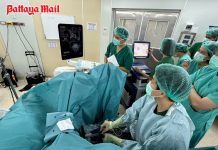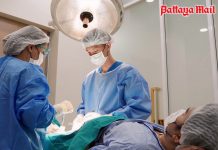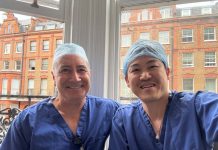A few weeks ago, I had what I thought was an inconsequential minor fall, more of a slip really when climbing some steps. “Ouch” and that was it and I continued climbing. The next morning my knee was aching and a little stiff, but you ignore these minor problems as you get older.
Only problem was the next morning it was worse and I couldn’t bend my knee enough to out my sock on. You feel a right proper nerd asking your wife to help you put your socks on!
However, since I have always worked on the principal that it (insert ailment here) will be better tomorrow, I swallowed a couple of anti-inflammatory pills and waited for the magic to happen. Unfortunately the magic didn’t!
In my long career in medicine I have never specialized in orthopedics, and since this was developing into a full-blown bone problem I took myself off to see Dr. Suradej in my hospital’s orthopedic department. It did not take him long to diagnose my problem. A tear in the meniscus cartilage, with odd bits of debris floating around limiting the range of movement in the knee.
By this stage the knee was exquisitely painful and I was getting close to begging for the knife but remembering Rule 1, I would wait to see if it were better in the morning. It wasn’t.
Dr Suradej put up with my foibles, but suggested that it really was time for an MRI scan of the knee, and by the way, a walking stick can help. The MRI showed that the meniscus cartilage was indeed torn, and as an aside, the knee was showing the wear and tear of age. I was quite accepting of that fact, but I also pointed out to the Radiologist that my left knee was exactly the same age as the right one, and it was not in trouble. (That is something to remember if a doctor tells you that age is the cause of the problem – the rest of your body which is OK is exactly the same age!)
So I soldiered on, using the stick and grimacing when climbing stairs, while muttering the mantra “It will be better in the morning”. Of course as a doctor you get all the guffaws when you have anything wrong with you and calls of “Doctors don’t get sick,” and “Heal yourself doctor.” It does get a bit tiresome.
Eventually, as the pain got worse and I couldn’t even get a decent night’s rest, I wearily made my way to Dr Suradej’s consulting room. I was by now pleading, “Do something to stop the pain!”
Dr Suradej confirmed what he had been telling me for the past few weeks and the only decision was ‘when’ should we do the surgery. By that stage I was ready to beg for the operation on bended knee over broken glass (other than the fact I couldn’t bend the damn knee)! That, by the way was one of the lessons I was taught as a young surgeon – never talk a patient into an operation, but let the patient come to the doctor ‘wanting’ the op! The perceived outcome is always better.
And so the train of events began to unfold, getting me inexorably closer to the operating table and the surgeon’s scalpels. The process of admission really is quite a process, but designed with the safety of the patient in mind. One’s date of birth is one identifier, as well as name, age and address. The site of the proposed operation was also thoroughly investigated. These are factors which are so necessary to ensure Right Patient, Right Procedure, Right Side. I felt rather confident that all the correct procedures as set down by the Joint Commission International were being followed.
After finishing with Admissions, I was given the date and time that I should check in at the hospital, which was the following Friday afternoon, ready for my op at 9 a.m. Saturday morning.
So suitably kitted out in a revealing housecoat with ties at the back that normal humans cannot reach, I took to my bed, and unpleasant dreams!
Part 2 next week from the pre-op through to the post-op!




